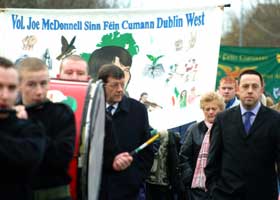9 December 2004 Edition
Remembering Martin Savage

Pat Doherty and Councillor Felix Gallagher on the Martin Savage commemoration
On Saturday, the annual Martin Savage commemoration took place in Dublin, organised by the Joe McDonnell Sinn Féin Cumann, Blanchardstown. Some 150 people attended, including members of the Savage family, who had travelled from Sligo and members of the Cohen/Savage Cumann in Sligo. Two bands led the parade from Castleknock village to the memorial at the Halfway House in Ashtown.
Guest speakers were Sinn Féin Vice President Pat Doherty and Mary Lou McDonald MEP and chairing proceedings was local councillor Felix Gallagher.
A daring ambush
The IRA campaign against the British forces gathered momentum gradually after the first Dáil met on 21 January 1919, the same day that the Soloheadbeg ambush left two RIC men dead. By the end of the year, the IRA had demonstrated that it was capable of launching large-scale operations and that it had the support of the population in its actions.
IRA intelligence operatives were scouring the country for information, which would be useful to its flying columns as they planned operations against the British forces in Ireland. One such operation, authorised by GHQ, was an attack on the British Direct Ruler Lord French, who was also the British Army's supreme commander in Ireland.
Intelligence sources in Dublin Castle knew he would be travelling back from his private residence, Frenchpark, County Roscommon, by rail and would be disembarking at the isolated train station at Ashtown. There, he would be met by an armed escort, including three cars and an outrider, as they finished their journey to the Vice-Regal Lodge in the Phoenix Park.
A special unit chosen for the operation reconnoitred the area for several days and selected the most appropriate site for the ambush, to take place on the morning of 19 December 1919. The unit consisted of some very experienced Volunteers — Tom Kilcoyne, Mick McDonnell, Joe Leonard, Dan Breen, Seán Treacy, Vinnie Byrne, Martin Savage, Seamús Robinson, Paddy Daly, Tom Keogh, and Seán Hogan.
At 11.40am, as the train pulled in, the unit took up positions at the crossroads at Ashtown. The plan was that three Volunteers, Tom Keogh, Martin Savage and Dan Breen, were to push a hay cart halfway across the road. They would push it the rest of the way when the outrider and the first car passed them. Lord French was to be in the second car and this would be attacked with grenades and concentrated rifle fire.
When the convoy appeared, the operation swung into action. The Volunteers concentrated their fire on the second car and hurled Mills bombs and hand grenades in its direction. Fire was returned and a fierce gun battle took place. The second car careered off the road and as the firefight continued, it became clear that French was not one of the occupants. The third car now arrived on the other side of the cart and began firing with rifle and machine gun on the now exposed volunteers. They were caught between two lines of fire. Dan Breen was shot in the leg as he broke cover and moment's later, IRA Volunteer Martin Savage, aged 21, was fatally wounded with a rifle bullet through the neck. Tom Keogh, and the wounded Dan Breen, succeeded in dragging Savage's body from the road while the fight continued.
At this stage, the British force began to withdraw from the scene, leaving one dead and one unconscious Dublin Metropolitan Police member behind them. The Volunteers carried Savage's body into Kelly's pub, now the Halfway House. The unit then dispersed to safe houses in the Dublin area. Dan Breen was helped back onto his bicycle and was brought to a safe house in Phibsboro, where he was attended by the captain of the Dublin hurling team, Dr JM Ryan.
The audacity of the ambush focused international attention once again on Ireland and gave a renewed impetus to the war against the British occupation forces and its administration in Ireland.
After an inquest, Martin Savage's body was handed over to his family and he was buried with full military honours in his native Ballisadare, County Sligo. A stone now marks the spot were Savage made the ultimate sacrifice for his country and every year he is commemorated by local republicans.


